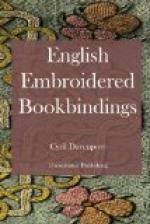Of book-plates themselves I have no claim to speak; but for good taste and grace of design the best English Jacobean and Chippendale specimens seem to me the most pleasing of their kind, and certainly in our own day the work of Mr. Sherborn has no rival, except in that of Mr. French, who, in technique, would, I imagine, not refuse to call himself his disciple.
I have purposely left to the last the subject of Bindings, as this, being more immediately cognate to Mr. Davenport’s book, may fairly be treated at rather greater length. If the French dictum ’la reliure est un art tout francais’ is not without its historical justification, it is at least possible to show that England has done much admirable work, and that now and again, as in the other bookish arts, she has attained preeminence.
The first point which may fairly be made is that England is the only country besides France in which the art has been consistently practised. In Italy, binding, like printing, flourished for a little over half a century with extraordinary vigour and grace, and then fell suddenly and completely from its high estate. From 1465 to the death of Aldus the books printed in Italy were the finest in the world; from the beginning of the work of Aldus to about 1560 Italian bindings possess a freedom of graceful design which even the superior technical skill quickly gained by the French does not altogether outbalance. But just as after about 1520 a finely printed Italian book can hardly be met with, so after 1560, save for a brief period during which certain fan-shaped designs attained prettiness, there have been no good Italian bindings. In Germany, when in the fifteenth century, before the introduction of gold tooling, there was a thriving school of binders working in the mediaeval manner, the Renaissance brought with it an absolute decline.




